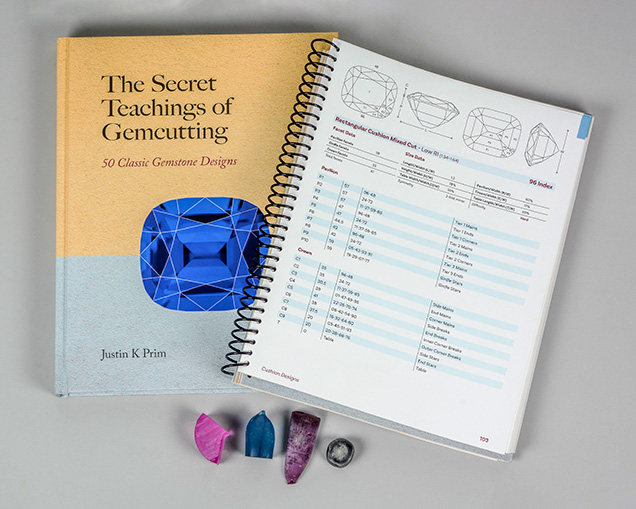Book Review: The Secret Teachings of Gemcutting: 50 Classic Gemstone Designs

In the world of gemology, books are rarely published on the subject of lapidary arts or gem cutting. The most recent of such books that this author can recall is the invaluable two-volume reference guide by Tom Herbst titled Amateur Gemstone Faceting (2014). In all likelihood, the reason we don’t see more books on the subject is that there isn’t much new information to be added to the volume of work already available. However, Justin Prim has found a gap in the available published work on faceting and filled it with The Secret Teachings of Gemcutting: 50 Classic Gemstone Designs.
In this 237-page book, the reader will find that the first 32 pages contain explanatory notes on how to use the book, basic information on gemstone design, gemology, evaluating rough, and a brief summary of the history of gemstone design. The following 200 or so pages are the reference portion dedicated to the 50 classic gem designs with detailed cutting instructions and related diagrams. This section has been neatly organized by shape and cutting style, covering round, oval, cushion, square, rectangle, emerald, fancy, and other historic and rose cut gem designs. Hobbyist faceters who are most familiar with meetpoint faceting (using the intersection of facets, or meetpoints of three facets as a reference for facet placement) may find the cutting instructions a bit challenging. The designs presented are not well suited to the meetpoint style, as none of the designs utilizes a faceted girdle, except for square, rectangular, and emerald cut stones. However, the cutting method outlined with its curved girdle is largely responsible for giving this faceting style its very classic appeal. In the author’s experience, most other widely available reference books on faceting have not focused on gem design in this way, and Mr. Prim has done a wonderful job in filling that gap. He has also provided cutting angles for high and low refractive index gems, another novel approach not often seen in instructional gem cutting books that will prove to be highly valuable to the reader.
To test the information presented in the book, I used a rectangular cushion mixed-cut diagram to facet an 11.16 ct pink synthetic sapphire. The instructions and angles worked nicely, and the design was also “test cut” in the computer-aided design faceting software GemCad with no issues. Aside from the curved unfaceted girdle style, which this reviewer was not familiar with but picked up quickly, the work went smoothly and the explanations offered were very easy to understand. Any reasonably experienced gem cutter will find the information in this book very useful.

The Secret Teachings of Gemcutting is available in either a hardcover ($100) or a clever spiralbound softcover ($80) that will prove useful in its ability to lie flat while referencing the cutting diagrams while faceting. The printing is on high-quality heavy paper, and the handsome design and layout are very minimalistic and pleasing to the eye. This reference book will be extremely appealing to anyone interested in faceting gems. The project was originally offered as a Kickstarter crowdfunding campaign, and copies of the book at the time of this review are available for order at www.magusgems.com.



